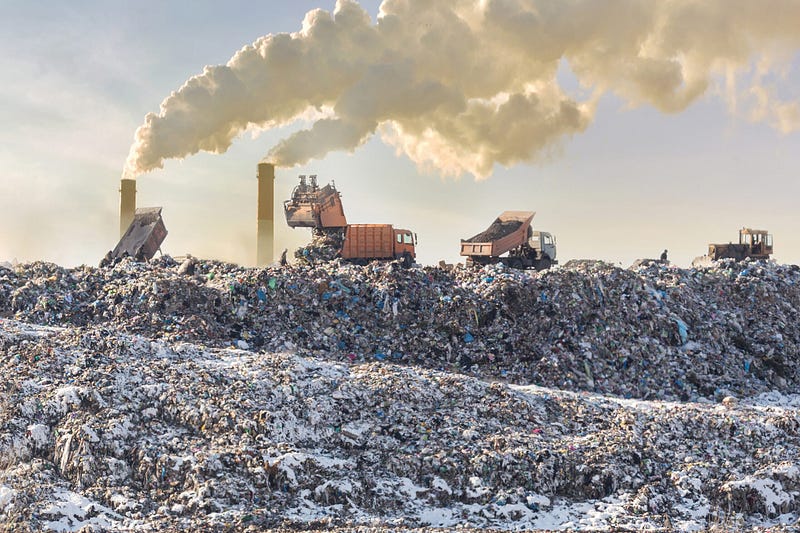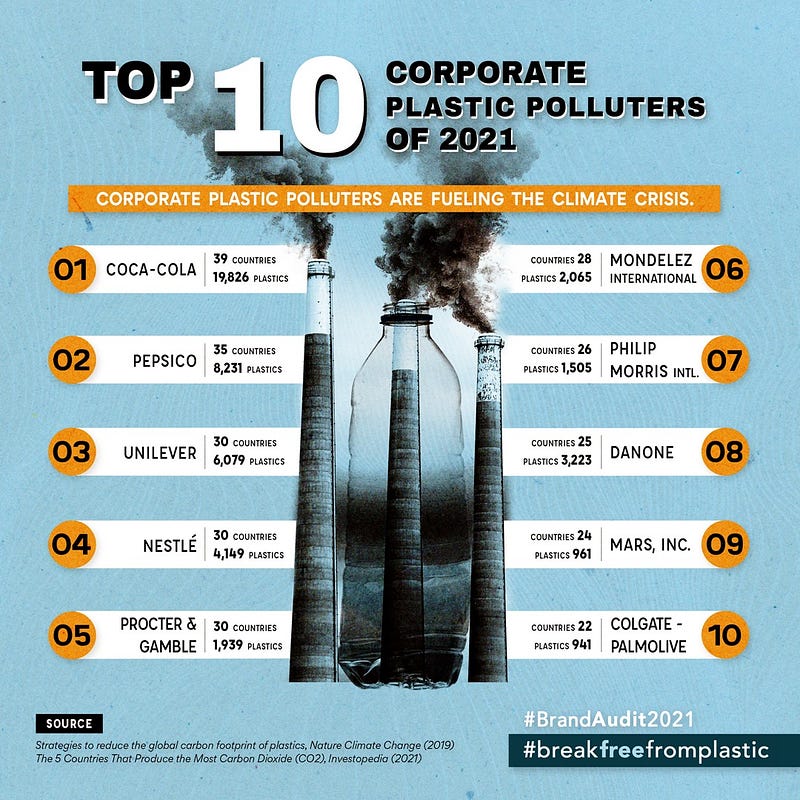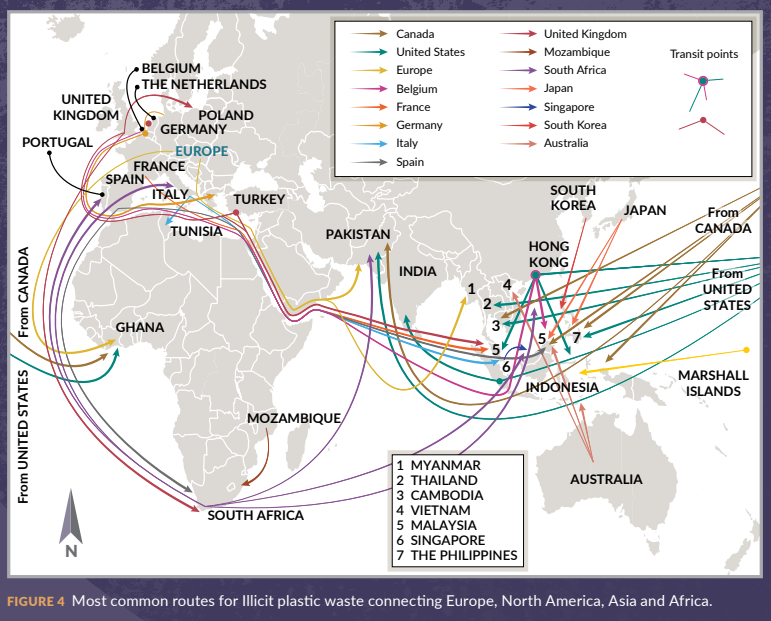The Waste Industry's Hidden Crimes and Environmental Impact
Written on

You may drink a soda, discard the bottle, and assume it's gone for good, but that bottle doesn't disappear. Instead, it becomes part of a lucrative waste industry that seeks to extract value from discarded materials. Recyclable items are sold around the globe; if you're in a wealthy country, your bottle might end up being processed in a recycling facility in Southeast Asia or Eastern Europe, possibly becoming anything from a toilet seat to fashionable sneakers. If not, it may end up in an illegal dump in countries like Malaysia or Turkey, where impoverished waste pickers, often children, sift through heaps of Western waste.
For years, what we believed was being recycled actually found its way to poorer nations with cheap labor and minimal regulation, leading to a form of ‘toxic colonialism.’ The waste clogging rivers in Asia could very well be yours. Worldwide, only 20% of household waste is recycled.
Why the deceit? Waste is an unpleasant topic, one we instinctively shy away from, which allows the waste industry to function largely unnoticed. Garbage trucks often operate during the early hours or late at night, and waste facilities are typically located out of sight. We offload our refuse onto the margins of society and the marginalized.
Despite its obscurity, this industry generates billions. The saying "one man's trash is another man's treasure" certainly rings true for those willing to handle the mess.
Consequently, waste has long been a target for criminal activity.
Crime in the Waste Industry
The waste sector has always been a magnet for crime, thanks to its combination of high profits, low-skilled labor, and a general absence of oversight. People generally don't inquire into what happens to garbage, making it easier to conceal illicit activities.
In the U.S., the mafia dominated the waste trade on the East Coast for decades, using private waste collection as a cover for organized crime. This hidden operation generated hundreds of millions annually and met resistance with threats of violence, including severed dog heads sent with warnings. Even in the 1990s, corporate waste companies like Waste Management Inc. found it challenging to penetrate this territory.

Similar narratives unfold globally. In Japan, the Yakuza takes advantage of the waste business, while in Honduras, the MS-13 gang uses landfills as a front. In Buenos Aires, the Chinese supermarket mafia was involved in violent disputes, leading to a body being found in a landfill.
In Italy, waste crime is closely tied to the mafia. Since the 1980s, Italian gangs have been importing waste from countries such as Germany and Australia for illegal dumping in places like Ghana and Egypt. The Ndrangheta mafia has even sunk ships loaded with toxic waste, including radioactive materials, off the coasts of Italy and North Africa. In Campania, the Camorra mafia buried over 10 million tons of hazardous waste, resulting in a rise in cancer cases and earning the area the nickname ‘Triangle of Death.’
In the UK, waste crimes have become so widespread that a specialized Joint Unit for Waste Crime was formed in 2021. The government intercepts around 500 illegal waste shipments each year and monitors approximately 1.3 million cases of illegal dumping, or ‘fly-tipping.’ Among 60 organized crime groups involved in waste crimes, 70% were linked to money laundering. One organization reportedly used waste shipments to smuggle drugs, banking on customs not scrutinizing garbage shipments closely.
The Accepted Crimes of Waste
PRODUCTION
From ancient times to the present, waste has chronicled human history. The post-World War II era saw the introduction of plastic, which flooded the world with waste and reshaped our perceptions of it. The term "disposable," once linked to luxury items, became commonplace, leading to a culture of "throwaway living." The waste industry didn't just clean up after our consumer habits; it fueled them. Corporations shifted from producing durable goods to creating cheap, disposable products, fostering planned obsolescence while shifting the repercussions onto consumers.
The modern economy thrives on waste.
To combat the litter crisis in the 1980s, major plastic companies invested heavily in recycling campaigns. However, this was more about avoiding legislation than genuine concern for the environment. Privately, they recognized the impracticalities of recycling due to issues like plastic degradation and sorting challenges. Recycling became a convenient distraction from environmental concerns.
As Larry Thomas, former president of the Society of the Plastic Industry, stated to NPR: “If the public thinks that recycling is working, then they are not going to be as concerned about the environment.”
A familiar pattern emerged: lofty promises of increased recycling and new facilities, only to be abandoned when the attention faded. Coca-Cola’s internal documents illustrated a calculated strategy regarding impending legislation—preparing, monitoring, and resisting. Despite pledging to use 100% recycled materials for certain bottles, the company actively lobbied against effective measures like deposit return schemes.
A 2016 internal document leaked to Greenpeace revealed that Coca-Cola, the world’s worst plastic polluter, had a strategic approach to upcoming laws, preparing and countering them.
This issue isn't confined to Coca-Cola; PepsiCo, Nestlé, and others have also failed to meet their plastics recycling goals. Media often highlights corporate pledges, but accountability for unfulfilled promises is rare. The plastic industry’s hollow commitment to recycling serves to maintain the illusion of progress in addressing the waste crisis.

EXPORTATION
So, what do you do if you're a leading country in plastic pollution with heaps of mixed, contaminated, and unprofitable plastic waste?
You pass the burden to someone else.
By the 1980s, Western nations were overwhelmed by waste. The global economy offered a quick solution: offshoring the problem. Container ships that once returned empty began sailing back filled with trash. Between 1988 and 2018, China processed 47% of global plastic waste exports. However, in 2018, China implemented the ‘National Sword’ policy, halting imports due to contamination concerns, which sent shockwaves through the global recycling market.

In the aftermath, waste began flooding into countries like Thailand, Indonesia, and Vietnam, which had high rates of waste mismanagement. Trash overflowed from inadequate recycling facilities and into open landfills, while smuggling operations thrived. The cycle continued, with waste exported to Turkey, Poland, Bulgaria, Romania, Mexico, and El Salvador, irrespective of international agreements.
No country wants to be the world's dumping ground, prompting 187 nations to sign a Basel Convention amendment in 2019 aimed at restricting plastic exports. Yet, both the U.S. and China remain among the few that have not ratified it.
Nonetheless, the flow of waste persists, as the waste industry remains a lucrative business.

The One Reason Why The Waste Industry is Undefeatable
On February 2, 1968, one of the world's most iconic cities began to resemble a slum, prompting authorities to declare a state of emergency for the first time since the 1931 polio epidemic. It took a week for the realization to settle in: the sanitation workers were going to win. The city capitulated, ending the strike, and it became clear that in this metropolis of skyscrapers and finance, the true heroes were those who picked up the trash.
> And The New York Times lamented: “This greatest of cities must surrender or see itself sink in filth.”
We are drowning in an unprecedented amount of waste.
Globally, 2.01 billion tonnes of solid waste are produced each year. On average, people generate 0.74 kilograms of waste daily. In the U.S., the most wasteful nation, individuals produce around 2 kilograms per day. OECD countries, which represent only 16% of the global population, account for 30% of organic waste. Wealthier nations generate more waste, and as developing countries gain wealth, this issue will likely worsen, with projections indicating an additional 1.3 billion tonnes of waste annually by 2050, much of it in the Global South. Consider that over 480 billion plastic bottles are sold every year, equating to one million bottles per minute. This is just one example among countless items that require management.
This is why waste management has become a corporate enterprise dominated by a few large multinational companies: there is an endless supply of waste, but no one wants to confront the unpleasantness of it. Despite projecting a respectable image, legal disputes and allegations of criminal behavior continue to plague the Big Waste industry, raising ethical and legal concerns. In the U.S., Waste Management Inc. has faced charges ranging from antitrust violations to bribery, settling over 200 cases, including a high-profile $30 million lawsuit for accounting fraud in 2005. In the UK, Biffa was found guilty of trying to export contaminated wastepaper to China and was involved in the nation’s largest modern slavery case.
Ultimately, waste represents a profit-driven global issue, with corporate interests frequently overshadowing environmental and humanitarian concerns.
The Waste Horror Tale of Our Own Making
Archaeologists have pieced together our history from refuse: broken weapons, shattered pottery, and food scraps with bite marks still visible. Waste reveals much about people: their lifestyles, diets, farming practices, conflicts, loves, and beliefs. Each discarded item tells a story.
The horror story we are currently crafting with our waste is a troubling narrative of our era.
Mismanagement of landfills accounts for about 6% of global emissions, exceeding the combined emissions from shipping and aviation. If waste were a country, it would rank as the third-largest emitter of carbon dioxide worldwide, following the USA and China.
The most alarming fact? One-third of food produced for human consumption is wasted globally. Approximately 13,800 square kilometers of agricultural land, larger than Qatar, is dedicated to food that ultimately goes uneaten. This wasted food could feed two billion people. Yet, according to the World Food Programme (WFP), over 345 million individuals face severe food insecurity, and as many as 783 million go hungry. Around 9 million people die from hunger each year, including 3.1 million children.
Furthermore, wasting food equates to squandering the resources, time, and energy spent on its production. Agriculture consumes 70% of the world’s freshwater resources, making food waste a critical drain on these supplies. Discarding just one kilogram of beef wastes 25,000 liters of water used in its production. With persistent carbon emissions, mainly from the fossil fuel sector, climate change has led to an impending water crisis, with demand expected to exceed supply by 40% by the end of this decade.
Addressing our waste crisis goes beyond simply cleaning litter from our rivers and oceans (though that's crucial too). Waste intersects with climate change and food security. Waste is a matter of life and death.
We must raise our voices to disrupt this horror story. Systemic changes in the waste industry, global economies, and political frameworks are essential. Only through collective action and a powerful demand for change can we hope to rewrite the narrative of this modern horror tale.
Until then, waste will continue to accumulate in an endless and hidden mass.
Be loud.
Thank you for your thorough reading and support! Subscribe for immediate insights and join the 400+ Antarctic Sapiens community for weekly thought-provoking content.